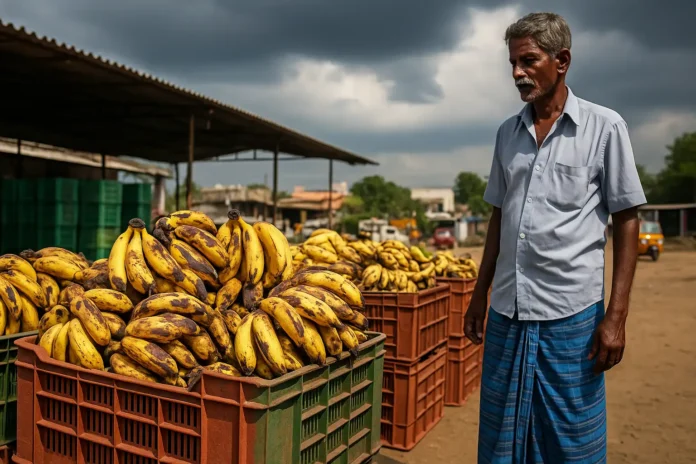As the India cold storage crisis worsens, procurement exposure rises from Tamil Nadu to West Bengal.
Perambalur district, Tamil Nadu – Banana grower Muniyandi Rajendran walks past crates softening in the midday sun. The cold storage facility promised last season never materialized. “If it rains tomorrow, half this load goes to waste,” he says, glancing at the darkening sky. “We’re losing before we even sell.”
That forecast may not be metaphorical. On Aug. 11, local MP N. Arun Nehru submitted a formal request to the Agriculture Ministry for an emergency cold storage unit in the Trichy -Karur–Perambalur belt. This isn’t long‑term agri‑policy – it’s immediate loss prevention. Farmers are dumping uncooled fruit into overstretched local mandis. Cooperative buyers say wastage is running above 30 percent in some lots.
Over 1,400 kilometres northeast, the numbers are colder—but no less alarming.
In West Bengal, cold storage is at a breaking point. Cold storage facilities are holding a record 70.85 lakh metric tonnes of potatoes, warned Sunil Kumar Rana, president of the West Bengal Cold Storage Association (WBCSA), as volumes surge past normal August levels. Yet wholesale prices have collapsed to Rs 9–12 per kilogram—upending farmer margins just ahead of the Q4 market ramp. Storage operators are warning of a financial time bomb. Ingredient buyers are facing unprecedented volatility in raw potato costs—just as Q4 demand forecasts come due.
India’s cold storage crisis is visible here in real time.

India’s Cold Storage Crisis Is a Contract Risk for Global Buyers
For GSN readers, this story lands in the inbox, not the fields.
Procurement teams in Europe and MENA sourcing from India now face a compressed timeline to reassess 2025 contracts. Cold-chain operators in Central India, where pulses and tubers dominate, have already raised storage prices by 2 percent—weeks ahead of their normal cycle. With 90 percent-plus capacity and rising electricity rates, operators are enforcing minimum duration clauses and full-season billing—even for partial volumes.
For buyers reliant on stored produce—potatoes, carrots, onions—this shifts cost assumptions mid‑cycle. One buyer at a Gulf-based importer, briefing off the record, said: “We’re seeing price revisions land before we’ve signed our Q4 purchase orders. That’s not typical. That’s pressure.”
Meanwhile, the sourcing risk extends upstream. Wastage in South India could tighten available supply by 15 to 25 percent in select SKUs. For retailers banking on Indian-origin bananas, the result could be substitution costs, fill‑rate penalties, or shelf gaps.
The India cold storage crisis is no longer a domestic issue — it’s a cascading procurement risk across Europe and MENA.

Sourcing Optics: ESG Officers Face a New Kind of Heat
For ESG and compliance leads, the optics are shifting fast.
Images of surplus bananas rotting in roadside bins or potatoes dumped below cost already circulate in regional media. Farmer unions are turned to state capitals with grievances. The narrative is shifting—from inefficiency to negligence.
This becomes material for Western retailers the moment “responsible sourcing” is part of their pitch. Any claim tied to food-waste reduction, fair-trade procurement, or supply-chain resilience is now vulnerable—especially if traceability audits expose buyer silence on infrastructure failure.
“We can’t ignore systemic waste on the supplier side while pushing ESG metrics on packaging and CO₂. It’s going to bite,” said a compliance manager at a Dutch grocery chain, on record, requesting anonymity due to internal sensitivities.
NGOs and trade regulators are already watching. A Delhi-based agri-policy expert warned that documentation around export storage practices may become “a political as well as regulatory flashpoint” by year-end.
The European Union’s banana production is expected to drop 16 percent in 2025—down to 566,592 metric tonnes from 676,603 tonnes in 2024. That contraction leaves the market more reliant on imports precisely as India’s cold chain falters.
Automation Meets Exposure: Infrastructure Teams on the Clock
Cold-chain infrastructure, once an invisible utility, is now a live risk register.
As more operators deploy automated racking, IoT tracking, and AI forecasting, insurance exposure is rising. Brokers are flagging a sharp uptick in claims related to ransomware and operational‑tech outages—especially in perishable inventory facilities.
Underwriters are asking hard questions: Is the HVAC system air-gapped? Are predictive systems patch-managed? What’s the response time on a breach?
For logistics and infrastructure directors overseeing automated cold storage or fulfillment centres, the implication is clear: check your cyber clauses now. Many existing policies do not include OT-layer vulnerability coverage under standard terms.
“This isn’t about a file server going down,” said James Harrington, risk consultant for a major UK grocery group. “It’s about ice cream melting for six hours because a warehouse sensor was spoofed.”
August Is the Red Line, Not the Warning Sign
This isn’t prep time. It’s already play time.
Retailers and suppliers who treat these cold‑chain fractures as distant or seasonal may find themselves reacting from behind come October. Bananas that failed to clear Tamil Nadu will tighten processed-fruit supply in Q4. Potatoes dumped from Bengal stores will reroute starch and frozen volumes into costlier corridors. Tech teams may deploy smart lockers and tri-temp vans—but fulfillment gaps won’t be fixed if the back‑end freezes, literally… or digitally.
Across procurement, ESG, logistics, and risk, the most urgent actions are internal:
- Audit contracts for mid‑cycle price exposure, especially from India’s pulse, tuber, and banana exporters.
- Activate ESG traceability reviews before holiday-season audit and reporting deadlines.
- Pressure-test infrastructure policies for cold‑chain cyber‑breach coverage.
Because what’s melting in India isn’t just produce. It’s margin, trust, and resilience—at exactly the moment retailers can’t afford to lose any of the three.



